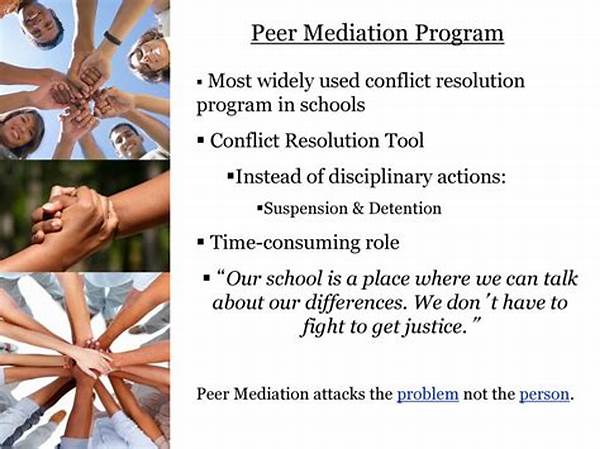Once upon a time, in a bustling city filled with towering skyscrapers and neighborhoods pulsing with life, there was a small school tucked away among the buzzing streets. This school wasn’t just any ordinary institution; it embodied a unique spirit of collaboration and harmony. Inside its walls, was a remarkable initiative that had begun to take shape, destined to change the lives of its students: peer mediation programs in schools.
Read Now : Discovering Auditions Near You
The Dawn of Understanding: Initiating Peer Mediation
In this vibrant school, each student carried their own set of challenges. While some struggled with friendships, others faced intense academic pressure. Amidst the whirlwind of adolescence, conflicts often bubbled beneath the surface, threatening to spill over into chaos. Yet, the teachers and administrators refused to let discord take root. They sought a solution that would transform conflict into understanding. Thus, the peer mediation programs in schools were born.
These programs, which trained students to become mediators, allowed peers to resolve disputes amicably. It wasn’t only about resolving disagreements—it was about instilling empathy and understanding, equipping students with skills that would serve them for a lifetime. Within a few months, the change was palpable. Suspensions decreased, hallways became more serene, and a new sense of community began to flourish. Students who once carried the weight of conflict learned to share their burdens, finding common ground through conversation and collaboration, all thanks to peer mediation programs in schools.
Stories of Transformation: Lives Changed
A young girl named Sophie, once shy and withdrawn, gained newfound confidence by participating in the program.
School bully Jamie found redemption, as the mediation sessions helped him reconcile with past grievances.
Teachers marveled at students, once adversaries, discussing and resolving their conflicts like seasoned diplomats.
Parent-teacher meetings echoed with tales of improved behavior, as parents noticed their children embracing understanding and compassion.
In the library, an informal club grew, where students voluntarily gathered to share insights from their mediation experiences, igniting interest across the school.
Building Bridges: The Role of Student Mediators
In the mosaic of a school’s social structure, peer mediation programs in schools symbolized a bridge connecting disparate islands of student groups. The mediators became architects of relationships, diligently building connections between once-divided cliques. Sarah, a bright-eyed mediator, recounted a session where two rivals came together. Their initial hostility melted away through guided dialogue and shared stories. By the end, they were laughing over shared interests and plans for a joint class project.
For the mediators themselves, the program was a journey of personal growth. They honed skills like active listening, emotional intelligence, and conflict resolution, which would serve them well beyond the classroom. These young leaders discovered the power of empathy, realizing that understanding others’ perspectives could dismantle walls that miscommunication had built. Slowly, but surely, peer mediation programs in schools were weaving a tighter fabric of community, one conversation at a time.
The Impact on School Culture
Peer mediation programs in schools gradually became the heart of the institution’s culture. Each mediation session contributed to a palpable shift in the school environment.
1. Assemblies once filled with the usual announcements now featured storytelling sessions of successful mediations.
2. New students were introduced to the program as a hallmark of the school’s commitment to harmony.
Read Now : Enhancing Audition Resume Tips
3. Parent engagement soared as workshops on mediation skills were held, mirroring the values instilled in students.
4. Administrators noticed a dip in administrative paperwork as fewer disciplinary issues reached their desks.
5. Teachers found joy in teaching students who were more focused and less burdened by personal conflicts.
6. Extracurricular clubs started mimicking the mediation model to resolve internal disputes, spreading the ethos further.
7. The sense of empowerment among mediators spilled over into academics, boosting participation and leadership.
8. Student-led clubs merged ideas with mediation principles, enhancing creativity and collaboration.
9. The school’s reputation rose within the district, setting a benchmark for others.
10. Resilience became a common thread in students’ journeys, fortifying them for future challenges with grace and insight.
A Future of Possibilities: Expanding Horizons
The magic of peer mediation programs in schools stretched far beyond its participants. This burgeoning initiative sparked a vision for the future, weaving a narrative of endless possibilities. As word spread, neighboring schools took notice, intrigued by the ripple effect emanating from the small school in the city. Meetings ensued, where educators and parents gathered to witness firsthand the transformations within the institution.
Inspired by the program’s success, other schools started adapting similar initiatives, fostering dialogues across districts about the value of student-led conflict resolution. Aspiring mediators came forth, eager to carry the torch within their communities. They exchanged stories with Sophie, Jamie, and Sarah, igniting a collective passion for fostering peace. Peer mediation programs in schools, once just an idea, had become a movement, bridging gaps and building relationships far and wide. Its legacy, now etched into the narrative of education, promised a future where every student could be understood, heard, and valued—a future where every school could be a sanctuary of understanding and growth.
